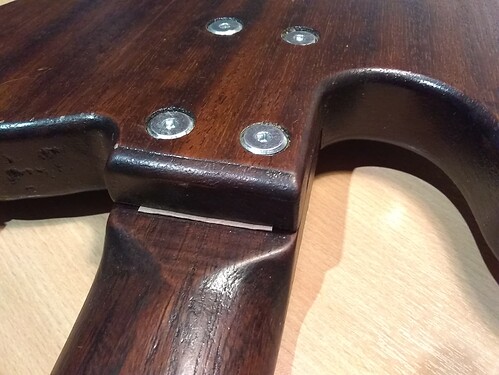I noticed while playing my Warmoth 54P that the action was a little higher than I like. So, I started to adjust the neck and found out the saddles were bottomed out already. I ordered a set of shims from StewMac (quite expensive for three thin pieces of wood). They sent a .25, a .50 and a 1.0. I used the .50 and it allowed me to lower the action quite a bit, maybe too much. I think I am going to go back in and use the .25 shim to get a good range of adjustability both up and down…
I’ve been thinking about shims of late and realizing I don’t know enough. I suspect I’ve got a few bases that would benefit from them, not in a “bottom order out” mode but more of a lower action up the neck mode.
I’m not able to find a good guidepost video on this topic that goes past the bottomed out thing. When to use, how to know etc.
At the moment it’s in the black magic camp for me.
StewMac makes tapered shims that work perfectly. I do think the .50 raised the fretboard a touch too much. I think perfection will be when I put in the .25 tomorrow and re-set it back up. I think the goal is to set it to allow for a good range up and down on the saddles. With no shim the saddles were pretty much bottomed out. With the .50 they are raised way up. The .25 should allow lots of range. But damn, those three little pieces of wood were expensive. $47.00 I think with shipping.
So you put the shim where the neck is bolted? I never heard of this so I am quite interested.
Yes, because of variances in the wood there are no exacts. You in effect raise the entire fretboard up which brings the strings down and lowers the action. Then adjust the saddles to your perfect height with no buzz or clanking. Works like a charm. Some people use a business card or something like that. What I read says don’t do that. It will disintegrate over time and be unstable.
The StewMac shims are a perfect fit on Fender type necks and others. Holes are pre-cut to line up with the bolts. And they’re tapered.
Shims are routinely used by acoustic guitar luthiers, and have been for decades, especially for vintage guitars that had no truss rods.
Ideally, modern guitars and basses shouldn’t need them, with adjustable truss rods and saddles being the way to dial in string action. However, such is not always possible. Therefore, the need for precise shims makes the scene.
Players have used matchbook covers and other paper for this purpose, and, sometimes, the fix has lasted quite a while. But it’s an imperfect solution.
StewMac has always been obscenely extremely proud of their products. But at least they are generally of high quality. So there’s that.
I’ve used cut down business cards for a shim, was free, worked well, and you could hardly notice it.
StewMac shims when installed you can’t really tell that the neck has any shims. The other brass ones you can see. They function about the same. I’d put the cheap ones on my Squiers and fenders imports any day of the veeek and twice on Sunday, but I’d probably spend extra on my Premiums.
I’ve never heard of doing this, but it makes sense. Frankly, if it comes from StewMac, I would have complete confidence in it.
Shimming is a process that has been used since the earliest days of stringed instruments lutherie, including lutes.
The adjustable truss rod system is a comparatively recent invention in comparison.
The adjustable truss rod was invented by a Gibson employee, Thaddeus McHugh, and patented in 1921. This invention made it possible to straighten a minor neck curve with the twist of a nut. This first truss rod was a 1 /8″ steel rod that had one threaded end with a nut installed.
You should cite your copy paste references so folks know where to find more info, and, so we know if it’s you typing a thought or copying someone else’s….
You found it. There it is. I just did a quick Google to remember the name of the guy who invented the adjustable truss rod, which was the point of the post.
Prior to this, I have written several articles for Acoustic Player Magazine on vintage Martin guitars and their restoration and repairs.
Sometimes you just need fine adjustment, I use brown paper shims during initial set up…
shim the front of the pocket to lift the headstock, back of the pocket to drop the headstock, or the whole pocket to lift the fretboard.

Business cards work perfectly for shimming nuts; not sure why the neck would be different but willing to believe it. I used them with nuts before and they were great.
The StewMac shims will have the advantage of a perfect fit. Only for a small number of models, but for those models they will likely be the best choice.
I did this on my 1970s Stratocaster and just got various thicknesses of oak plane shavings from a cabinet makers shop. Worked well and the price was right ![]()
Well, the .50 raised the fretboard a wee bit too much. Saddles were raised almost all the way up. I changed to the .25 and it is perfect. Good adjustability both ways.
Glad you got it homed in, Eddie. 
Forgive me. OCD strikes. “Honed”
